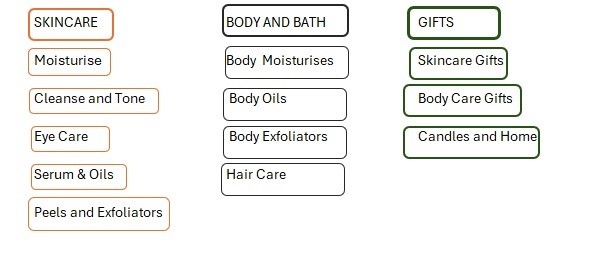The Art of Product Hiearchies - Benefits for your Salon retail or Spa Retail
Product Categories - what are they for and to maximise their benefits
PRODUCT RANGESPRODUCT SELECTIONBEST SELLERSPRODUCT CATEGORIES
1/25/20245 min read
In the challenging world of hair salons, spas, and beauty salons, diversifying income streams through retail offerings can be a game-changer, from a financial point of view. One key strategy that can elevate your retail game is understanding and implementing effective product hierarchies.
1.- Unveiling the Mystery of Hierarchies
So, what exactly is a hierarchy in the context of retail? Think of it as a structured roadmap that organizes your product offerings from the broadest to the most specific. At the top of the hierarchy, you have departments, representing major categories in your inventory. For a haircare brand, these could be departments like shampoos, conditioners, treatments, and color. Move a step down, and you have categories, diving deeper into each department's nuances.
Let's delve into an example with a renowned spa brand, Elemis:


It is a very clear and easy to follow hiearchy, categorising product by its end use. It is worth that an item, can not belong in two different categories, or you risk double accounting. On a website a product may be shown in more than one category, but it can only be recorded in one location in the product hiearchy.
Beyond departments and categories lie attributes, distinctive characteristics that differentiate products—whether it's color, size, or collection. These attributes pave the way for in-depth analysis of sales and stock data, unlocking potential opportunities for strategic growth. In the case Elemis one attribute would be collection, Pro-collagen being the most obvious example. Another attribute which Elemis is clearly using is 'concern', what is the product treating. Attributes allow you to validate and confirm what up to know had been assumptions
Now, you might wonder, why bother with hierarchies? Picture them as your retailing compass, guiding you through the maze of offerings. Here are a few reasons why hierarchies are indispensable:
A. Performance Tracking:
With hierarchies, you gain a comprehensive view of each department and category's performance. This bird's-eye perspective allows you to identify trends, best-sellers, and underperforming areas.
B. Resource Allocation:
Efficiently allocate resources by comparing the money invested, stock levels, and physical space devoted to each department or category. This strategic approach ensures that your investment aligns with the product's demand and popularity.
C. Trend Spotting:
By tracking sales and stock data through hierarchies, you become a trend-spotting maestro. Identify emerging trends, customer preferences, and areas with untapped potential, giving you the agility to adapt and evolve your product offerings.
2. The Power of Hierarchies: Why they matter
3. Crafting the perfect range: The Elemis example
Let's circle back to Elemis to understand how hierarchies contribute to building the perfect product range:
A. Sales Mix Alignment:
Utilize hierarchies to align your stock mix with your sales mix. Ensure that popular categories receive ample shelf space, creating a harmonious balance between customer demand and inventory availability. Furthermore, a higher mix of sales than stock in a particular category is a sign of an opportunity area, a growth category
However, as with most things, it is not as clear cut as it sounds. Seemingly identical situations will be better approached with fairly different solutions. Let's look again at how Elemis is performing in our imaginary Spa. For a few months now Peelers and Exfoliators have been doing well, sales are consistenly up on the years, growing its mix of the total sales, while the mix of stock has remained at the same level for the last 12 months. Only occasionaly you have been out of stock for more than 2 days
You have got three choices:
You bring new peelers and exfoliators, it is a growth area, and customers like newness
You increase your stock on your current products, so any point in time you will always have more of all of them. Obviously, buying deeper on best sellers.
You don't make any significant changes to your stock, just increase your forecast slightly so you bring a bit more of the same and probably more often.
Each of these solutions would be the correct approach under certain conditions
Option 1 could be the right thing to do in some of the following cases:
All of or almost all of your peelers and exfoliators are doing well, with good Rates of Sale,
You are struggling to secure supply on your current products, so you are going to test some new SKUS;
Elemis are launching a new range, so instead of you can over-index the category and select 2 instead of 1 as you normally would have done.
Action 2: This would be best solution for situations such as
You got a category which is completely dominated by a bestseller, what is also know as a category killer, particularly if the product does deliver and it is not just pure marketing.There is little point in trying to get your customer to purchase something else. However, at the same time that you continue to offer your clients what they want, you should be testing new lines. You don't want to put all your eggs in one basket
You got a category which is performing well, with some strong bestsellers. However, the category could be very narrow, and any extra product would not offer anything new to the customer.
Action 3:
If you have been occasionally out of stock on the bestseller of a category and your supplier has not constrained your intake for the category, ie you let yourself run out of stock, You need to review your ordering process, ensure that your are not too cautious to the point of damaging your salesare you being too cautious and not ordering enough?
B. Attribute Analysis:
Once products are attributed with characteristics like color or size, dive deep into your sales and stock data. Identify patterns and correlations, allowing you to tailor your offerings to meet customer preferences effectively.
C. Avoiding Self-Fulfilling Prophecies:
While hierarchies guide decision-making, be cautious not to fall into the trap of self-fulfilling prophecies. Strive for a balanced mix that includes both proven performers and innovative newcomers to keep your product range dynamic and appealing.
If you analysis is clearly warning you that category is in decline, you need to cut back on the stock you hold, de-risk it. However, declining does not always mean that you should be exiting a category. The category could still be relevant, just sized correctly. If you have decide to continue a product category, you need to do it some level of authority. Cut back too far and the decline will accelarate
In conclusion, mastering product hierarchies is an art that empowers hair salons, spas, and beauty salon owners to elevate their retail strategies.
Through thoughtful categorization, insightful analysis, and strategic decision-making, you can craft a retail experience that not only meets but exceeds customer expectations. So, embrace the power of hierarchies and let your retail offerings shine!
Elemis Product Hierarchy


Contact details
roberto@retailsalesservices.co.uk
+44 (0)7450408610
Supporting hair and beauty businesses achieve higher and more profitable retail sales
We are so confident in our ability to boost retail profits that we offer a 100% money back guarantee
